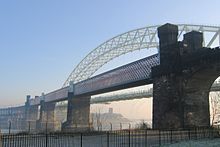William Baker (engineer)




William Baker (19 May 1817 – 20 December 1878) was an English railway engineer.
Between 1834 and 1839 Baker was articled to
He was a consulting engineer in the construction of the 1862 International Exhibition building.[2]
Following the death of Robert Stephenson he was appointed chief engineer of the London and North Western Railway Company. He wholly constructed, or remodelled and extended, the stations of the company in London, Liverpool and Manchester, as well as the stations in Birmingham, Preston, Bolton, Crewe, Warrington and Stafford.[1] He constructed a new harbour at Holyhead and was responsible for designing and overseeing the building of the Runcorn Railway Bridge.[3] Baker was designer and engineer of the Battersea Railway Bridge.[4] He also acted as consulting engineer to the West London Extension Railway and the North London Railway, and in Ireland he built the Dundalk, Newry and Greenore Railway and the North Wall Extension Railways. He was elected MICE in 1848.[1]
Works
- Oxley Viaduct, Gorsebrook Road, Wolverhampton 1847-49[5] (with Robert Stephenson)
- Belvidere Bridge, Uffington, Shropshire 1848 (now bridge number 438)[6]
- Bridges on the Manchester South Junction and Altrincham Railway Viaduct 1849 (bridge over the Rochdale canal survives, bridge over Egerton Street replaced in 1976)[7]
- Viaduct, Stafford Road, Wolverhampton 1849-51 (with Robert Stephenson)[8]
- North Wall extension railway, Dublin 1861
- Wigan, Tyldesley and Eccles Railway 1861-64[9]
- Cremorne Bridge, Battersea 1863[10]
- Manchester Piccadilly railway station 1862-66[11]
- Stafford railway station 1862
- Goods shed south east of Stafford railway station ca. 1862[12]
- Buxton Road Railway Bridge, Whaley Bridge ca. 1863[13]
- City extension on the Kingsland Viaduct from Dalston Junction to Broad Street of the North London Railway 1864-65[14] (with William Lawford (resident engineer))
- Crewe railway station 1867[15]
- Liverpool Lime Street railway station 1867[16] (with Francis Stevenson)
- Warrington Bank Quay railway station 1867-68
- Runcorn Railway Bridge 1868[17]
- Earlestown wagon factory 1868 (extensions)[18]
- Standedge Railway Tunnel (second bore) 1868-71[19]
- Euston railway station 1870 (enlargement)[20]
- Dundalk, Newry and Greenore Railway 1873
References
- ^ a b c "Biographies of Civil Engineers". steamindex.com. Baker, William. Retrieved 23 April 2008.
- ^ "Death of Mr. William Baker". Birmingham Daily Post. England. 23 December 1878. Retrieved 20 February 2022 – via British Newspaper Archive.
- ^ Cowan, C. A. (1990), Crossing the Runcorn Gap, Vol. 3: Runcorn Railway Bridge, Halton Borough Council
- ^ London's Thames Bridges basic facts, Brian Cookson, retrieved 23 April 2008
- ^ Historic England, "Oxley Viaduct (1201817)", National Heritage List for England, retrieved 20 February 2022
- ^ Historic England, "Bridge Number 438 (Belvedere Bridge) (1177239)", National Heritage List for England, retrieved 20 February 2022
- ^ Historic England, "Manchester South Junction and Altrincham Railway Viaduct (1200837)", National Heritage List for England, retrieved 20 February 2022
- ^ Historic England, "Viaduct on Stour Valley Line (1293282)", National Heritage List for England, retrieved 20 February 2022
- ^ "Cutting the first sod of the Wigan, Tyldesley and Eccles Railway". Wigan Observer and District Advertiser. England. 13 September 1861. Retrieved 20 February 2022 – via British Newspaper Archive.
- ^ Historic England, "Cremore Bridge, West London Extension Railway Bridge, Battersea (1393005)", National Heritage List for England, retrieved 20 February 2022
- ^ Historic England, "Train shed and undercroft at Manchester Piccadilly Station (1283014)", National Heritage List for England, retrieved 20 February 2022
- ^ Historic England, "Goods Shed South-East of Stafford Railway Station (1389629)", National Heritage List for England, retrieved 20 February 2022
- ^ Historic England, "Railway Bridge (1119771)", National Heritage List for England, retrieved 20 February 2022
- ^ "City Extension of the North London Railway". Railway News. England. 9 January 1864. Retrieved 20 February 2022 – via British Newspaper Archive.
- ^ Historic England, "1867 buildings at Crewe Railway Station (1436435)", National Heritage List for England, retrieved 20 February 2022
- ^ "Enlargement of the Lime-Street Railway Station". The Albion. England. 27 May 1867. Retrieved 20 February 2022 – via British Newspaper Archive.
- ^ "Runcorn Bridge". Chester Courant. England. 30 September 1868. Retrieved 20 February 2022 – via British Newspaper Archive.
- ^ "London and North Western Railway". Railway News. England. 30 May 1868. Retrieved 20 February 2022 – via British Newspaper Archive.
- ^ Historic England, "Railway tunnel portals MVL3/40, east end of Standedge Tunnel (1224282)", National Heritage List for England, retrieved 20 February 2022
- ^ "London and North Western Railway". Sun (London). England. 13 November 1869. Retrieved 20 February 2022 – via British Newspaper Archive.
